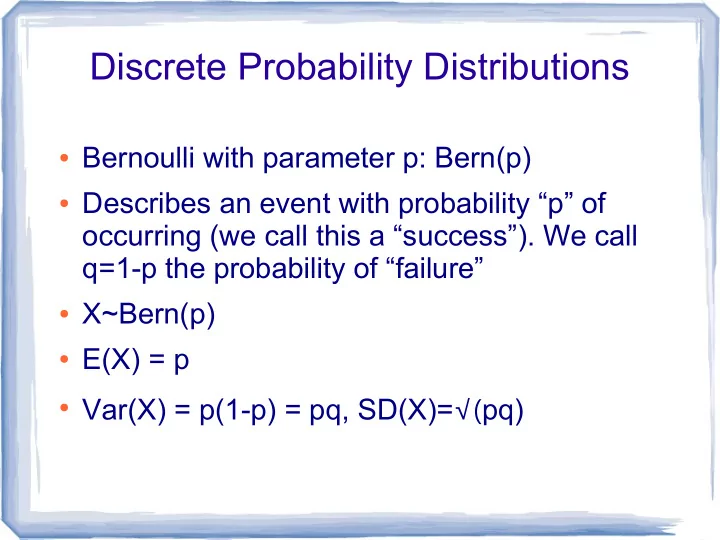

Discrete Probability Distributions ● Bernoulli with parameter p: Bern(p) ● Describes an event with probability “p” of occurring (we call this a “success”). We call q=1-p the probability of “failure” ● X~Bern(p) ● E(X) = p ● Var(X) = p(1-p) = pq, SD(X)= √( pq)
Bernoulli Example ● You drop your toast and as we all know toast has a 75% chance of landing butter side- down. If it lands butter-side down you need to buy new toast for $1, but if it's butter side up, the 5 second rule applies and you don't have to buy new toast! What is the expected cost and standard deviation of dropping toast? ● E(X)=p*$1=$.75 ● SD(X)= √Var(X)=√( pq)= √.1875≈$.433
Multiple Bernoulli Trials ● When we are performing multiple independent Bernoulli trials, we make new distributions ● Binomial Distribution: Models the number of successes obtained from “n” independent Bernoulli trials ● Geometric Distribution: Models the number of independent Bernoulli trials until (and including) the first success
Binomial Distribution ● X~Binom(n,p) means X follows a Binomial model of “n” independent trials with probability “p” of success ● P(X=k) is the probability of “k” successes ● P(X=k)=C(n,k)*p k *q (n-k) ● C(n,k) counts all combinations of k out of n (ie., which of the n trials are the k successes)
Binomial Histogram ● Histogram of Binomial(20, 0.50)
“n choose k” ( k ) n ● C(n,k) is sometimes written ● We say “n choose k” ( k ) = n! n ● The formula is k ! ( n − k ) ! ● The TI-83/84 has this built in. ● Go to [MATH]>[PRB] and choose “nCr” ● eg., “8 nCr 3” = 56. This means there are 56 possible combinations of 3 out of 8 things.
Back to the Binomial ● X~Binom(n,p) P ( X = k )= ( k ) p k q n n − k ● ● E(X)=np ● Var(X)=npq, SD(X)= √(npq) ● P(X≤k) = P(X=0) + P(X=1) +∙∙∙+ P(X=k)
Binomial Example ● An archer hits his mark 85% of the time. He fires 5 arrows. What is the probability that 3 of them hit? ● X~Binom(5,.85) because n=5, p=.85 P ( X = 3 )= ( 3 ) ( .85 ) 5 3 ( .15 ) 2 = .13817 ● ● E(X)=np=5*.85=4.25 ● Var(X)=npq=5(.85)(.15)=.6375 ● SD(X)= √Var(X)=√.6375=.7984
Geometric Distribution ● X~Geometric(p) means X follows a Geometric Model with probability “p” of success ● P(X=k) = p*q k-1 ● ie, the probability of 1 success and k-1 failures ● E(X)=1/p ● Var(X)=q/p 2 , SD(X)= √ (q/p 2 )
Geometric Histogram ● Histogram of Geom(1/3)
Geometric Example ● At the apple factory, a barrel of apples has a 4% chance of being spoiled. Your job is to do quality control. What is the expected number of barrels to check until you find a spoiled barrel? What is the Standard Deviation? ● X~Geometric(.04) so E(X)=1/.04=25 ● Var(X)=q/p 2 =.96/.04 2 =600 so SD(X)= √ 600 ≈ 24.5
Texas Instruments to the Rescue! ● TI-83/84 make use of the Geometric and Binomial models much easier ● [2nd][VARS] gives access to: – 0:binompdf( – A:binomcdf( – D:geometpdf( – E:geometcdf(
How to use TI-83/84 distributions ● binompdf(n,p,k) gives the probability of exactly k successes out of n trials with probability p ● binomcdf(n,p,k) gives the probability of k or fewer successes out of n trials ● geometpdf(p,k) gives the probability that it takes exactly k trials to get a success ● geometcdf(p,k) gives the probability that it takes k or fewer trials to get a success
Recommend
More recommend